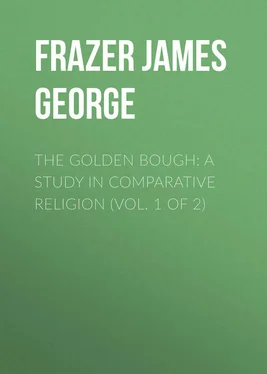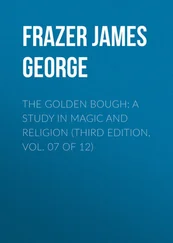James Frazer - The Golden Bough - A Study in Comparative Religion (Vol. 1 of 2)
Здесь есть возможность читать онлайн «James Frazer - The Golden Bough - A Study in Comparative Religion (Vol. 1 of 2)» — ознакомительный отрывок электронной книги совершенно бесплатно, а после прочтения отрывка купить полную версию. В некоторых случаях можно слушать аудио, скачать через торрент в формате fb2 и присутствует краткое содержание. Жанр: foreign_religion, foreign_antique, foreign_prose, на английском языке. Описание произведения, (предисловие) а так же отзывы посетителей доступны на портале библиотеки ЛибКат.
- Название:The Golden Bough: A Study in Comparative Religion (Vol. 1 of 2)
- Автор:
- Жанр:
- Год:неизвестен
- ISBN:нет данных
- Рейтинг книги:4 / 5. Голосов: 1
-
Избранное:Добавить в избранное
- Отзывы:
-
Ваша оценка:
- 80
- 1
- 2
- 3
- 4
- 5
The Golden Bough: A Study in Comparative Religion (Vol. 1 of 2): краткое содержание, описание и аннотация
Предлагаем к чтению аннотацию, описание, краткое содержание или предисловие (зависит от того, что написал сам автор книги «The Golden Bough: A Study in Comparative Religion (Vol. 1 of 2)»). Если вы не нашли необходимую информацию о книге — напишите в комментариях, мы постараемся отыскать её.
The Golden Bough: A Study in Comparative Religion (Vol. 1 of 2) — читать онлайн ознакомительный отрывок
Ниже представлен текст книги, разбитый по страницам. Система сохранения места последней прочитанной страницы, позволяет с удобством читать онлайн бесплатно книгу «The Golden Bough: A Study in Comparative Religion (Vol. 1 of 2)», без необходимости каждый раз заново искать на чём Вы остановились. Поставьте закладку, и сможете в любой момент перейти на страницу, на которой закончили чтение.
Интервал:
Закладка:
From this review of the beneficent qualities commonly ascribed to tree-spirits, it is easy to understand why customs like the May-tree or May-pole have prevailed so widely and figured so prominently in the popular festivals of European peasants. In spring or early summer or even on Midsummer Day, it was and still is in many parts of Europe the custom to go out to the woods, cut down a tree and bring it into the village, where it is set up amid general rejoicings. Or the people cut branches in the woods, and fasten them on every house. The intention of these customs is to bring home to the village, and to each house, the blessings which the tree-spirit has in its power to bestow. Hence the custom in some places of planting a May-tree before every house, or of carrying the village May-tree from door to door, that every household may receive its share of the blessing. Out of the mass of evidence on this subject a few examples may be selected.
Sir Henry Piers, in his Description of Westmeath , writing in 1682 says: “On May-eve, every family sets up before their door a green bush, strewed over with yellow flowers, which the meadows yield plentifully. In countries where timber is plentiful, they erect tall slender trees, which stand high, and they continue almost the whole year; so as a stranger would go nigh to imagine that they were all signs of ale-sellers, and that all houses were ale-houses.” 274 274 Quoted by Brand, Popular Antiquities , i. 246 (ed. Bohn).
In Northamptonshire a young tree ten or twelve feet high used to be planted before each house on May Day so as to appear growing. 275 275 Dyer, British Popular Customs , p. 254.
“An antient custom, still retained by the Cornish, is that of decking their doors and porches on the 1st of May with green boughs of sycamore and hawthorn, and of planting trees, or rather stumps of trees, before their houses.” 276 276 Borlase, cited by Brand, op. cit. i. 222.
In the north of England it was formerly the custom for young people to rise very early on the morning of the 1st of May, and go out with music into the woods, where they broke branches and adorned them with nosegays and crowns of flowers. This done, they returned about sunrise and fastened the flower-decked branches over the doors and windows of their houses. 277 277 Brand, op. cit. i. 212 sq.
At Abingdon in Berkshire young people formerly went about in groups on May morning, singing a carol of which the following are some of the verses —
“We've been rambling all the night;
And sometime of this day;
And now returning back again,
We bring a garland gay.
“A garland gay we bring you here;
And at your door we stand;
It is a sprout well budded out,
The work of our Lord's hand.” 278 278 Dyer, Popular British Customs , p. 233.
At the villages of Saffron Walden and Debden in Essex on the 1st of May little girls go about in parties from door to door singing a song almost identical with the above and carrying garlands; a doll dressed in white is usually placed in the middle of each garland. 279 279 Chambers, Book of Days , i. 578; Dyer, op. cit. p. 237 sq.
At Seven Oaks on May Day the children carry boughs and garlands from house to house, begging for pence. The garlands consist of two hoops interlaced crosswise, and covered with blue and yellow flowers from the woods and hedges. 280 280 Dyer, op. cit. p. 243.
In some villages of the Vosges Mountains on the first Sunday of May young girls go in bands from house to house, singing a song in praise of May, in which mention is made of the “bread and meal that come in May.” If money is given them, they fasten a green bough to the door; if it is refused, they wish the family many children and no bread to feed them. 281 281 E. Cortet, Fêtes religieuses , p. 167 sqq.
In Mayenne (France), boys who bore the name of Maillotins used to go about from farm to farm on the 1st of May singing carols, for which they received money or a drink; they planted a small tree or a branch of a tree. 282 282 Revue des Traditions populaires , ii. 200.
On the Thursday before Whitsunday the Russian villagers “go out into the woods, sing songs, weave garlands, and cut down a young birch-tree, which they dress up in woman's clothes, or adorn with many-coloured shreds and ribbons. After that comes a feast, at the end of which they take the dressed-up birch-tree, carry it home to their village with joyful dance and song, and set it up in one of the houses, where it remains as an honoured guest till Whitsunday. On the two intervening days they pay visits to the house where their ‘guest’ is; but on the third day, Whitsunday, they take her to a stream and fling her into its waters,” throwing their garlands after her. “All over Russia every village and every town is turned, a little before Whitsunday, into a sort of garden. Everywhere along the streets the young birch-trees stand in rows, every house and every room is adorned with boughs, even the engines upon the railway are for the time decked with green leaves.” 283 283 Ralston, Songs of the Russian People , p. 234 sq.
In this Russian custom the dressing of the birch in woman's clothes shows how clearly the tree is conceived as personal; and the throwing it into a stream is most probably a rain-charm. In some villages of Altmark it was formerly the custom for serving-men, grooms, and cowherds to go from farm to farm at Whitsuntide distributing crowns made of birch-branches and flowers to the farmers; these crowns were hung up in the houses and left till the following year. 284 284 A. Kuhn, Märkische Sagen und Märchen , p. 315.
In the neighbourhood of Zabern in Alsace bands of people go about carrying May-trees. Amongst them is a man dressed in a white shirt, with his face blackened; in front of him is carried a large May-tree, but each member of the band also carries a smaller one. One of the company carries a huge basket in which he collects eggs, bacon, etc. 285 285 Mannhardt, B. K. p. 162.
In some parts of Sweden on the eve of May Day lads go about carrying each a bunch of fresh-gathered birch twigs, wholly or partially in leaf. With the village fiddler at their head they go from house to house singing May songs; the purport of which is a prayer for fine weather, a plentiful harvest, and worldly and spiritual blessings. One of them carries a basket in which he collects gifts of eggs and the like. If they are well received they stick a leafy twig in the roof over the cottage door. 286 286 L. Lloyd, Peasant Life in Sweden , p. 235.
But in Sweden midsummer is the season when these ceremonies are chiefly observed. On the Eve of St. John (23d June) the houses are thoroughly cleansed and garnished with green boughs and flowers. Young fir-trees are raised at the door-way and elsewhere about the homestead; and very often small umbrageous arbours are constructed in the garden. In Stockholm on this day a leaf-market is held at which thousands of May-poles ( Maj Stănger ) six inches to twelve feet high, decorated with leaves, flowers, slips of coloured paper, gilt egg-shells, strung on reeds, etc. are exposed for sale. Bonfires are lit on the hills and the people dance round them and jump over them. But the chief event of the day is setting up the May-pole. This consists of a straight and tall spruce-pine tree, stripped of its branches. “At times hoops and at others pieces of wood, placed crosswise, are attached to it at intervals; whilst at others it is provided with bows, representing so to say, a man with his arms akimbo. From top to bottom not only the ‘Maj Stăng’ (May-pole) itself, but the hoops, bows, etc. are ornamented with leaves, flowers, slips of various cloth, gilt egg-shells, etc.; and on the top of it is a large vane, or it may be a flag.” The raising of the May-pole, the decoration of which is done by the village maidens, is an affair of much ceremony; the people flock to it from all quarters and dance round it in a great ring. 287 287 L. Lloyd, op. cit. p. 257 sqq.
In some parts of Bohemia also a May-pole or midsummer-tree is erected on St. John's Eve. The lads fetch a tall fir or pine from the wood and set it up on a height, where the girls deck it with nosegays, garlands, and red ribbons. Then they pile brushwood, dry wood, and other combustible materials about the tree, and, when darkness has fallen, set the whole on fire. While the fire was burning the lads used to climb up the tree and fetch down the garlands and ribbons which the girls had fastened to it; but as this led to accidents, the custom has been forbidden. Sometimes the young people fling burning besoms into the air, or run shouting down hill with them. When the tree is consumed, the young men and their sweethearts stand on opposite sides of the fire, and look at each other through garlands and through the fire, to see whether they will be true lovers and will wed. Then they throw the garlands thrice across the smouldering fire to each other. When the blaze has died down, the couples join hands and leap thrice across the glowing embers. The singed garlands are taken home, and kept carefully in the house throughout the year. Whenever a thunder-storm bursts, part of the garlands are burned on the hearth; and when the cattle are sick or are calving, they get a portion of the garlands to eat. The charred embers of the bonfire are stuck in the cornfields and meadows and on the roof of the house, to keep house and field from bad weather and injury. 288 288 Reinsberg-Düringsfeld, Fest-Kalendar aus Böhmen , p. 308 sq.
Интервал:
Закладка:
Похожие книги на «The Golden Bough: A Study in Comparative Religion (Vol. 1 of 2)»
Представляем Вашему вниманию похожие книги на «The Golden Bough: A Study in Comparative Religion (Vol. 1 of 2)» списком для выбора. Мы отобрали схожую по названию и смыслу литературу в надежде предоставить читателям больше вариантов отыскать новые, интересные, ещё непрочитанные произведения.
Обсуждение, отзывы о книге «The Golden Bough: A Study in Comparative Religion (Vol. 1 of 2)» и просто собственные мнения читателей. Оставьте ваши комментарии, напишите, что Вы думаете о произведении, его смысле или главных героях. Укажите что конкретно понравилось, а что нет, и почему Вы так считаете.












